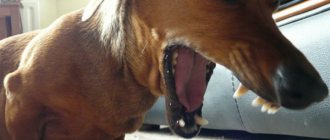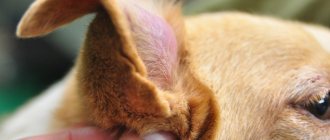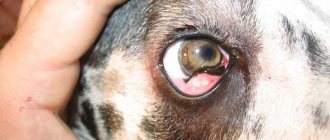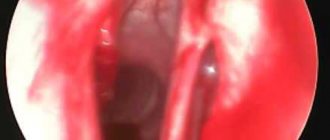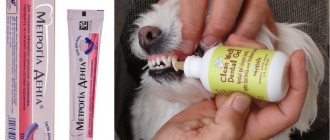Dogs are very curious by nature. but sometimes their curiosity leads to trouble. This is especially true for dogs - “vacuum cleaners” who eat a lot of strange things. What items did the doctors of our clinics remove from the dog’s gastrointestinal tract:
- socks,
- underpants,
- packages,
- ropes,
- threads,
- needles,
- toys,
- bones,
- sticks and many other finds!
Symptoms
Symptoms vary greatly depending on where the object is located - in the mouth, throat or esophagus, stomach or intestines.
A foreign body in a dog's mouth is usually sticks or bones that are stuck between the dog's back teeth. One of the first signs is frequent movement of the jaw, profuse salivation, the dog rubs its muzzle with its paws, and there may also be slight bleeding from the mouth.
Do not try to remove a stick or bone yourself! Even if you manage to loosen the object, it may move into the throat.
Contact your nearest veterinary clinic; a doctor's examination is necessary; sedation may also be required to remove the foreign body from the dog's mouth.
A foreign body in a dog's throat often causes signs of sudden suffocation and nausea. This condition often requires immediate intervention! As first aid, the owner can lift the dog by the hind legs and shake it; in an emergency, you can sharply squeeze the chest from the sides several times.
A foreign body in a dog's esophagus: signs - vomiting after eating, dehydration. To check whether your animal is dehydrated or not, collect a fold of skin on the dog's withers and release it, it should return to its normal position quickly.
When a dog has a foreign body in the trachea and lungs, the general depression of the animal increases at an alarming rate. You must consult a doctor immediately!
A foreign body in a dog's stomach is more difficult to diagnose. Some foreign bodies can remain in the stomach for several years without visible problems. But if the foreign body moves, it can lead to periodic vomiting.
A foreign body in a dog's small intestine usually causes uncontrollable vomiting, dehydration, and severe pain in the abdominal wall.
A foreign body in the dog's rectum: if it is sharp objects - sticks, bone fragments, needles, etc. - the dog hunches over repeatedly, constipation and blood in the stool are possible.
It is important for owners to follow the rule: never pull on a foreign object that is protruding from your pet's rectum! This can be very dangerous, even leading to intestinal rupture.
Almost all foreign bodies in the gastrointestinal tract are objects that are consumed by the animal. One exception is trichobezoars (hairballs). Threads and strings swallowed by your dog often become wrapped around the back of the tongue. Carefully examine your pet's oral cavity!
Symptoms that require you to contact a veterinarian:
- Vomit
- Diarrhea
- Abdominal pain (the dog does not allow himself to be picked up, his back is hunched)
- Anorexia (lack or decreased appetite)
- Straining during bowel movements, constipation
- Lethargy
- Dehydration
Diagnostics
Diagnosis requires a general blood test, biochemical blood test, and urine test. These findings help rule out other causes of vomiting, diarrhea, anorexia, and abdominal pain. It is necessary to take x-rays using a contrast agent.
Ultrasound and gastroscopy are recommended. All these research methods are used in veterinary clinics of the Svoy Doctor network. Additional tests may include blood tests for hormones to rule out specific metabolic diseases.
Analysis of feces to exclude gastrointestinal parasites and other studies.
A foreign body in a dog must be differentiated from inflammatory bowel diseases (enteritis), gastritis, pancreatitis, ulcers, gastrointestinal neoplasia, endocrine diseases - hyperthyroidism, hypoadrenocorticism (Addison's disease) in elderly animals.
A foreign body in a dog that causes intestinal obstruction, prolonged vomiting, or diarrhea can lead to significant metabolic changes in the body.
In addition, a foreign body can cause perforation of the organ wall and exit into the chest or abdominal cavity, leading to profound complications such as peritonitis, sepsis and death.
Many foreign bodies consist of toxic materials that are absorbed by the body - this leads to profound systemic diseases.
Treatment Options
There are several treatment options depending on your dog's condition. If you have recently swallowed foreign objects, you may try to induce vomiting. It is also necessary to remove mineral oil, which facilitates the passage of foreign bodies through the gastrointestinal tract within 48 hours.
Some objects can be removed using an endoscope. If the animal has symptoms such as vomiting blood or severe pain, then intravenous infusions and painkillers are necessary. Your veterinarian will suggest admitting your dog to the clinic for observation.
The decision to operate is usually made on the basis of X-rays and ultrasound results. A blockage in the intestines or stomach can reduce blood flow to the GI tissues, which can become necrotic. If the foreign body is in the stomach or intestines, the object is removed by making an incision in the intestines or stomach.
If there are necrotic tissues and parts of the intestine, they are also removed.
After the operation, intensive therapy is carried out with intravenous fluids, painkillers and antibiotics are administered. Feeding the dog after surgery begins 1 to 2 days later. It is advisable to use special diets for nutrition at first.
Forecast
In most cases, dogs with foreign bodies that do not cause blockages have a good prognosis. However, in general, the prognosis depends on several factors:
- property location
- duration of obstruction caused by the object
- size, shape and characteristics of the object
- whether or not the object will cause secondary diseases
- the general health of the dog before the foreign body enters
Prevention
- eliminate bones from the diet
- Don't let your dog chew sticks
- Keep an eye on the animal during games and walks; if the dog is prone to wandering, put a muzzle on it
- Ask your veterinarian for advice when choosing harmless toys for your dog.
- if your dog often eats strange objects, consult the doctors at our clinics; there may be a general metabolic disorder
And remember – your pet’s life is in your hands.
Source: https://www.svoydoctor.ru/vladeltsam/poleznoe/stati.html?show=477
Prevention, how to protect your pet from such a pathology
First of all, do not leave your pet unattended in a place where he could swallow or eat something. On the street, the dog must be under constant supervision and walked on a leash or nearby. Do not forget that the animal is excellent at opening garbage containers and it will not be difficult for her to grab leftover food. Some tips for owners:
- completely eliminate bones from the animal’s diet;
- if the dog is prone to wandering, wear a muzzle on the street;
- choose toys for your dog or buy special treats;
- do not allow chewing on sticks.
If your pet likes to chew or eat strange objects, consulting a veterinarian is important: perhaps he has a metabolic disorder or something is missing in his body. It is very important to accustom the animal to the command “Fu!”, to inspect the dog’s mouth on the street, if there are prerequisites. Remember, your pet’s health is solely in your hands!
Foreign body in a dog's esophagus
One of the causes of damage to the gastrointestinal tract in dogs is a foreign body that, for various reasons, was swallowed by the animal.
This often happens during active play (small toys, chewing large objects into pieces), eating (large bone fragments, eating packaging), as well as when a dog eats inedible objects on the street.
A variety of foreign bodies are found in the gastrointestinal tract of dogs - from pieces of polyethylene and fragments of toys to items of clothing of the owners.
Signs that may indicate that an animal has swallowed foreign objects
- The urge to vomit or vomiting of varying severity.
- Diarrhea, often mixed with blood.
- Pain in the abdominal area, which manifests itself as hunching and soreness when touched.
- Decreased appetite up to complete absence.
- Visible straining when trying to defecate.
- Dehydration.
- Apathy, lethargy.
Other symptoms of foreign bodies in a dog depend on their location in the gastrointestinal tract.
Objects entering the esophagus often lead to blockage. Complete obstruction is characterized by restless behavior, neck stretching, drooling, retching, and frequent attempts to swallow. Palpation determines a limited area of swelling with severe pain.
With incomplete obstruction by a foreign body in the esophagus, the dog may maintain appetite, but vomit during meals. Sharp objects can cause a rupture in the wall of the esophagus, which leads to the formation of an abscess or cellulitis in the affected area. Dehydration and general depression develop.
Foreign body in the stomach of a dog
If a foreign object has passed the esophagus and entered the stomach, the leading symptom is irritation of the mucous membrane. Perforation of the walls is possible from the impact of not only sharp, but also blunt objects with a large mass or volume. When the stomach is perforated, its contents exit into the abdominal cavity, leading to the development of peritonitis.
A dog has a bone stuck in its throat: symptoms
The first and most obvious symptom of a foreign body getting stuck in a dog’s throat is that it starts coughing. The cough may be accompanied by vomiting, while the pet strongly stretches its neck and tries to swallow.
The vomit contains food particles, foam and blood from scratched cavities.
There can be no talk of any appetite: the dog even refuses water because it hurts to swallow.
The first thing the owner must do here is to make sure that the bone is stuck in the throat. The following symptoms will help you figure it out.
If the bone is stuck in the mouth, the pet will only show the urge to vomit, but nothing more. The dog scratches its face with its paws, on the carpet or corners.
The dog swallowed a foreign body - what to do
Fighting methods
Having a small puppy in the house requires the owner not only to treat the animal with care and provide food in a timely manner, but also to comply with basic home safety rules:
- no sharp, small or piercing objects on the floor,
- lack of household chemicals in free access,
- handicraft items (scissors, threads, needles) at an unattainable height,
- sweet wrappers (from foil) immediately into the trash bin,
- The dog should not see nuts, crackers, seeds,
- river fish with many bones, chicken and beef bones with sharp edges should be excluded from the diet forever.
But despite all the precautions, it is impossible to foresee everything. If trouble occurs, you must immediately help your dog.
Symptoms of foreign body ingestion depend on where the object
Oral cavity:
- swallowing function is impaired
- increased salivation
- gagging
- lack of appetite
- The dog restlessly rubs its cheeks on the surface or rubs its head with its paws
Laryngeal area:
- doesn't eat
- heat
- swelling of the larynx
- breathing problems
- may be suffocation
- bleeding, in case of a sharp object
Esophagus area:
- complete or partial blockage
- inflammatory process followed by necrosis of esophageal tissue
- esophageal rupture cannot be ruled out
- the dog stretches its neck for relief
- after eating, vomiting white foam or food eaten
- sometimes lack of swallowing reflex
Stomach and intestinal area (most foreign bodies get stuck in the small intestine)
- serious condition with increasing deterioration
- doesn't eat
- constant thirst
- vomit
- lack of peristalsis with inability to go to the toilet
- bloating only when the walls are damaged
If the object is smooth, you can try non-surgical treatment:
- x-ray to understand the extent of the damage (the presence of rubber objects will not be shown by x-ray)
- Vaseline oil, envelops the object and is carried out with feces
- if the object is shallow, you can try to get it out using a medical forceps or tweezers, or, in the absence of tools, by hand. In this case, the animal’s face is fixed with an oral retainer; after the procedure is completed, the animal’s mouth can be irrigated with potassium permanganate from the esophagus using an esophagoscope; in case of failure, push the probe into the stomach (with great care, so as not to damage the walls of the esophagus; before the procedure, Vaseline oil is injected 2-3 times teaspoons per dose.
- a foreign body is expelled from the stomach by subcutaneous administration of emetics (papaverine - 0.1 g/kg IM; apomorphine - 0.01 g)
- in the presence of chills (an indicator of severe spastic pain), you should inject no-shpu 0.2 ml 2 times a day. This will relieve spasms of smooth muscles and may help move the foreign body through the intestines.
- laxatives, enemas, antiemetics are strictly prohibited if gastric or intestinal obstruction is suspected
If the above methods are ineffective, surgery is required
Medical care - surgical intervention consists of removing the foreign body through the opened intestinal wall; in severe cases, resection (excision of a section of intestine) is indicated.
After surgery on the esophagus, the dog is on parenteral nutrition through droppers with nutrient solutions. Internal bleeding may occur and the dog cannot always be saved.
Postoperative diet
- the first two days are hungry
- 3-7 days: meat broth, finely chopped meat, bread soaked in milk, liquid porridge.
- after 10 days they gradually return to their normal diet
- antibiotics (ceftriaxone, bottle 1 g or 500 mg, diluted with 0.5% novocaine, store the bottle in the refrigerator for a day, i.e. for 2 injections. Dosage 50 mg/kg. That is, dilute a bottle with 5 ml of novocaine, and if your dosage is 1 gram, then for a 5 kg cat you need to administer 250 mg, i.e. 1.25 milliliters, if the dosage is 0.5 grams, then the same 250 mg in the form of 2.5 ml) 5 day course
- wound treatment: wipe with chlorhexidine, then apply levomikol ointment to prevent suppuration of the sutures
- stitches removed after 2 weeks
In conclusion, I would like to wish that in this situation it is better to be on the safe side than to bite your elbows after losing a dog. Daily cleaning, attention to your pet, and learning not to grab everything will make your life together happy and serene, no matter how pretentious it may sound.
Source: https://minisobaci.ru/sobaka-proglotila-inorodnoe-telo—
A bone stuck in the esophagus - is it dangerous?
It is necessary to understand that most small bones (fish, chicken and others) do not have a serious negative effect on the human body. The small, bendable bone spontaneously moves out of place and moves further into the stomach, especially if it is pushed by a bolus of food. It was from this moment that the “folk way” of removing a stuck bone arose - to eat a crust of bread or something similar in hardness.
There are frequent cases of self-digestion and spontaneous dissolution of stuck bone. Digestive enzymes of saliva and the esophagus itself, as well as local immune defense factors, take an active part in this.
However, a completely different scenario is also possible, when a fish bone in the esophagus, firmly stuck in the tissues, can cause a big disaster. Particularly dangerous are hard, inflexible bones, bone fragments of large bones, that is, anything that can penetrate deeply into tissues and injure them.
The following complications may develop when a bone gets stuck:
- damage to a large vessel with the development of bleeding;
- foreign bone tissue can migrate from one place to another deep in the tissues of the neck;
- development of inflammation (abscess, phlegmon) at the site of bone penetration;
- spread of the inflammatory reaction to tissues close to the esophagus. Until the development of purulent inflammation of the mediastinum (mediastinitis) and the death of the patient.
Any of the worst scenarios for the development of the situation can be avoided if you consult a doctor in a timely manner.
What to do if your dog swallows a foreign body
Obstruction (blockage of the digestive tract by a foreign body) is one of the common reasons why owners with young animals seek an appointment with a veterinarian.
Every veterinarian has a collection of various foreign objects that have been removed from the digestive tract of pets. Most often these are various bones, toys, textiles, threads with sewing needles, and jewelry.
Such a misfortune can happen to any animal, even if its owner is extremely attentive.
To prevent your pet from having the desire to swallow foreign objects, you should carefully train the animal, and also regularly give it special treats for dogs that will satisfy the need to chew on everything (in addition, they are a good prevention of oral diseases).
A foreign body can lodge and cause blockage in any part of the digestive canal. The most common areas of the digestive canal in which foreign bodies become “stuck” are: the thoracic part of the esophagus immediately before the sphincter into the stomach, the body of the stomach and pyloric canal, and the duodenum.
Symptoms
Symptoms vary and depend on the location of the blockage, as well as the degree of obstruction of the canal. Many dog diseases have the same signs, so if they are detected, you should immediately contact a veterinarian for examination.
- If a foreign body is “stuck” in the esophagus, you may notice that your dog is coughing, restless, short of breath, lack of appetite, and hypersalivation (excessive drooling). In some cases, with preserved appetite, regurgitation occurs (dog food, untreated with gastric juice, is regurgitated by the animal).
- If a foreign body has entered the stomach, but its size does not allow it to pass further into the digestive canal, and it does not cause obstruction (blockage), clinical symptoms may be “erased”: for example, a dog may experience rare periodic vomiting, more often when hungry stomach.
- There are cases where a foreign body was discovered several years after ingestion. If a foreign body dissolves under the influence of gastric juice, this can lead to intoxication and cause poisoning in the dog by the products of the interaction of the foreign body material with gastric contents.
- Then the animal will show signs of intoxication, disruption of internal organs, etc.
If your dog has a bone stuck in its throat, what should you do?
There is profuse salivation. Obviously, the bone injures the gum if the dog squints and flinches when closing its mouth. In this case, you can pull out the fragment yourself, but in no case by touch - if it is small, there is a risk of driving it even deeper into the gum, or worse, pushing it down the throat.
If the bone is stuck in the larynx, the dog will obviously have difficulty breathing. A wheeze is heard. The temperature rises, the pet begins to shudder, the throat swells and turns red. In this case, it is necessary to assess the pet’s condition and one’s own strength - without timely assistance, the dog may suffocate. Veterinarians advise in such cases, if there is obviously not enough time to travel to the clinic, to quickly but carefully slightly tilt the pet down, press it with its back to your chest and make several squeezing movements - sharp, but not too strong, so as not to injure the dog. At the same time, the pet should not be afraid of you - a spasm of the pharynx may occur from severe fright.
If the bone has passed into the esophagus, the symptoms will not be as obvious: the dog may vomit, but will not cough or choke. There is still no appetite, but the pet drinks a lot. Please note if these symptoms include bloating and blood in the stool. Then you need to urgently take the dog to the veterinarian.
First aid if a dog has swallowed a foreign object
The symptoms of a foreign body in a dog depend greatly on where the object is located - in the mouth, throat or esophagus, stomach or intestines. I urgently need advice. There is an assumption that my dog swallowed a needle or part of it. She shows no visible concern. A foreign body in the dog's rectum: if it is sharp objects - sticks, bone fragments, needles, etc.
Dogs are very curious by nature. Gastrointestinal tract of dogs: socks, panties, bags, ropes, threads, needles, toys, bones, sticks and many other finds! A foreign body in a dog's mouth is usually sticks or bones that are stuck between the dog's back teeth.
As first aid, the owner can lift the dog by the hind legs and shake it; in an emergency, you can sharply squeeze the chest from the sides several times.
Some foreign bodies can remain in the stomach for several years without visible problems. A foreign body in a dog's small intestine usually causes uncontrollable vomiting, dehydration, and severe pain in the abdominal wall.
Almost all foreign bodies in the gastrointestinal tract are objects that are consumed by the animal.
Diagnosis requires a general blood test, biochemical blood test, and urine test. These findings help rule out other causes of vomiting, diarrhea, anorexia, and abdominal pain.
All these research methods are used in veterinary clinics of the Svoy Doctor network.
A foreign body in a dog that causes intestinal obstruction, prolonged vomiting, or diarrhea can lead to significant metabolic changes in the body.
Many foreign bodies consist of toxic materials that are absorbed by the body - this leads to profound systemic diseases. There are several treatment options depending on your dog's condition.
If the animal has symptoms such as vomiting blood or severe pain, then intravenous infusions and painkillers are necessary. Your veterinarian will suggest admitting your dog to the clinic for observation.
If there are necrotic tissues and parts of the intestine, they are also removed. In most cases, dogs with foreign bodies that do not cause blockages have a good prognosis. The impression is that nothing bothers her anywhere. But after the walk, while eating, I coughed a couple of times, as if something was stuck in my throat.
Hot on the heels, they usually do this: take cotton wool, straighten it, making a canvas with an area of approximately 8x8 cm, pour in vegetable or petroleum jelly oil and let it be swallowed. There will be perforation of the wall.
Source: https://prikaziwon.ru/sobaka-proglotila-inorodnoe-telo-vash/
What to do if your dog has a bone stuck in his intestines
As a rule, such candles can only be purchased in churches. Candles sold in supermarkets and hardware stores are made from paraffin, which is not suitable for us. Why? The fact is that wax has the ability to soften and melt at a relatively low temperature (body temperature is quite enough for this). The melted wax, passing through the esophagus and entering the stomach, envelops the bones it encounters along the way, due to which the likelihood of their successful exit is significantly increased. A wax candle will help if your dog has swallowed a sharp bone or any other small sharp object.
Paraffin, alas, does not have such properties, so in this situation it will be completely useless.
So, you will have to purchase the smallest available candles from the nearest church and cut them into small circles, getting rid of the wick. The mugs should be of such a size that the dog can eat them easily. If you have a large dog, give him half a candle 3 times a day. If the dog is a miniature breed, a few cm is enough. 60-70 minutes after “taking” the candle, feed the pet the same food and in the same quantity as you always feed it.
What will all these manipulations give? First, the eaten and melted wax will soften and round the bone that the dog swallowed; secondly, in the company of food, the bone will slide through the intestines much easier and scratch them less.
If there is no way to get a real wax candle, you can try feeding the dog regular cotton wool soaked in Vaseline or sunflower oil.
If you are sure that the swallowed bone is not sharp and is small in size, you can simply pour about 40-60 grams of Vaseline oil into the dog’s mouth.
Attention! If the bone the dog swallowed was larger than beef, do not try to solve the problem yourself, contact your veterinarian immediately!
In any case, after all the manipulations performed, the dog must be shown to a doctor. If her condition worsens, then this must be done immediately!
It is equally important to know what you should never do.
- Firstly, it is forbidden to give laxatives. The fact is that as a result of the action of any laxative, the intestines begin to contract strongly, which increases the likelihood of damage to its walls by a sharp bone.
- Secondly, you cannot induce vomiting in an animal for the same reason that taking laxatives is prohibited.
Is it possible to give bones to a dog?
Dogs do not need to have their teeth ground down and their bones do not contain any of the microelements they need.
You should not give bones to a puppy or an adult dog! Any bones in any quantity are dangerous.
- Puppies' milk teeth are replaced by permanent ones at the age of 3.5-6.5 months. How long they will last depends largely on genetic predisposition, the breed of dog and, of course, on feeding.
- If bones are present in the dog’s diet, then by the age of 6 years, and maybe earlier, the dog will have “stumps” instead of normal teeth. Dogs do not need to wear down their teeth, for example, like rodents, whose teeth grow continuously throughout their lives. Bones can also scratch the enamel, and a tooth can simply break, and treating teeth in dogs is very difficult.
- When giving a bone to a dog, you may not realize that it can get stuck between the teeth, injure the gums and palate, leading to bleeding; if it gets stuck, it can pinch the root of the tongue, which can cause it to swell to incredible sizes. All of these conditions are not life-threatening, but will cause you and your dog a lot of anxiety.
- A bone can get stuck in a dog’s esophagus (if the bone is not very large or tubular) and in order to remove it, you often have to contact a surgeon.
- Having reached the stomach, the bone may not pass further along the digestive tract and cause vomiting and other unpleasant symptoms in your pet, which will also most likely lead to surgery; The most dangerous thing that the bone you give can cause is intestinal perforation (when the bone breaks through the intestinal wall), which in the worst case scenario can lead to the death of your pet.
The dog ate the bones. What should I do?
Let's assume that you didn't keep track, and your pet killed the bones left after a feast or picnic. What to do? If the animal behaves normally (that is, there is definitely nothing stuck in its organs), you can try to give it first aid. Its “events” are as follows:
- Having overcome disgust, carefully examine the feces . If you see blood in it, or the dog groans and grunts with every bowel movement, take him to the vet immediately.
- You should also monitor your dog's behavior . If your dog becomes moody or apathetic, take him to the clinic immediately.
- Fortunately, in most cases, severe consequences can be avoided by feeding your dog a little more bulky food . A piece of bread and cooked rice (cold, of course) is ideal. They gently envelop the animal's intestines from the inside, preventing damage. If your pet doesn't like Japanese food, just mix rice, bread and his favorite treats. As a rule, after three to four days of such a diet, all the eaten bones come out naturally.
- even try to make your dog vomit! Solid objects cannot be removed this way because they will almost certainly pierce the esophagus and get stuck halfway down.
Foreign body of the esophagus in dogs
A foreign body in the esophagus in dogs is quite common in clinical practice. The most common foreign bodies found in dogs are bones, bone fragments and coins, while toys are more often found in puppies.
Many canine esophageal foreign bodies are expelled by regurgitation or move to the distal gastrointestinal tract, but some remain in the esophagus.
A large foreign body that cannot pass through the esophagus causes mechanical obstruction.
The severity of esophageal injury depends on the size of the foreign body, whether it has corners or sharp projections, and the duration of the obstruction.
Fish bone in the esophagus - symptoms and signs
There are symptoms of esophageal damage that everyone knows:
- sudden onset of pain immediately after swallowing a bone;
- increased pain after swallowing any food, but especially after solid food;
- Sometimes there is excessive salivation as a protective reaction of the body, trying to “wash away” the stuck bone.
Without a medical examination and special studies, it is impossible to understand whether there really is a foreign body in the esophageal tube or whether the bone has only scratched the esophagus. At the very beginning, the pain will be quite strong, however, then the intensity of the pain will decrease, which indicates in favor of a scratch and is caused by gradual healing of the injury site.
The following symptoms indicate serious injury and require immediate medical attention:
- a large bone is stuck in the esophagus, which was noticed by the person himself or others;
- there was very severe pain in the chest;
- vomiting mixed with blood is observed;
- the temperature has risen;
- Tachycardia (rapid pulse) occurred and the blood pressure suddenly dropped.
All of the above indicates a deep penetrating wound to the esophageal tube and requires immediate medical intervention.
Bones are dangerous, useless and useful
Particularly “good” in this regard chicken bones left over from grilled chicken, caught from soup, etc. That is, those that have undergone heat treatment. They become extremely fragile, and at the same time easily split into long and sharp fragments. Each of them can easily pierce the esophagus, stomach or intestines. Even in the mouth, such pieces can cause a lot of trouble.
Fish bones are a real killing tool. Never, under any circumstances, feed them to dogs! They cause intestinal blockage and puncture and puncture internal organs. Very often, after such a “feast,” dogs have to be operated on or completely euthanized.
Perhaps the “safest” ones are boiled beef and pork . True, their nutritional value is no more than that of sawdust. But even this variety has a tendency to split, so care should be taken in any case.
The only bones that can sometimes be given to a dog are the so-called “sugar” , with the remains of meat and veins. They are durable and practically unbreakable. However, their nutritional value is also zero. So why give them? The fact is that a dog that regularly chews such “treats” evenly wears down its teeth. In addition, these animals are several times less likely to suffer from tartar.
Foreign body removal and surgery
Having detected a foreign object using an x-ray examination and determined its location, the veterinarian immediately begins to remove the foreign body from the dog. The urgency of surgical intervention is dictated by the high risk of perforation of the walls of the esophagus, stomach or intestines with the subsequent development of bleeding and peritonitis.
If an object unnatural for the body is detected in the respiratory tract, urgent surgery is dictated to save the pet from asphyxia.
If in the stomach, intestines, esophagus
In veterinary practice, surgery to remove a foreign body from a dog is performed using several methods. The simplest and most effective is the use of a gastroscope equipped with operational functions. With its help, a veterinary surgeon defragments the foreign body and removes it. The disadvantage of this method is its high cost. High-tech equipment is available only in megacities.
If the X-ray does not reveal fluid accumulation in the abdominal cavity, there is no perforation of the esophagus, and no more than 3 days have passed since the object was swallowed, the veterinarian performs an intra-abdominal gastrotomy.
Access to the esophagus is through the stomach. During the operation, a gastric tube is inserted into the esophagus. After removing the foreign body from the dog's esophagus, the veterinary surgeon will stitch the stomach, remove fluid from the abdomen, and then stitch the peritoneum. If perforation of the esophagus is detected, its walls are first sutured.
In the event that the owner does not apply immediately, the foreign body is in the digestive tube for more than 4 days; in case of perforation of the esophagus, as a rule, an intrathoracic esophagotomy is performed to save the animal’s life. Operative access to the esophagus is carried out on the right side in the area of the 7th rib. After removing the foreign object, vacuum drainage is installed for a period of at least 5 days.
The dog underwent surgery to remove part of his intestines. The dog swallowed a sharp bone, resulting in intestinal perforation and peritonitis.
If a foreign body is found in the dog's intestines, it is removed by laparotomy. In some cases, a veterinary surgeon resorts to resection of a section of the intestinal tube if necrosis has occurred. In small pets, the intestine is sutured with a one-story suture; for surgical intervention in large animals, a two-story suture is used.
Postoperative care for your four-legged friend is carried out according to generally accepted surgical techniques with mandatory adherence to diet and antibacterial therapy.
To see how bones are removed from a dog's stomach, watch this video:
If in the throat, larynx, trachea
If a foreign body is found in a dog's throat, a veterinarian can remove it using long surgical tweezers or a forceps. For this procedure, the animal's jaws are fixed using a special jaw, which provides access to the larynx. This procedure is possible when a foreign object is located shallowly. After removal, the mouth is irrigated with an antiseptic solution. For this purpose, use a solution of furatsilin, potassium permanganate.
The owner should understand that untimely assistance in a situation where a foreign body is in the dog’s trachea can lead to serious complications such as emphysema, pleurisy, and pneumothorax. Typically, a veterinarian will perform endoscopic removal of the foreign object. The operation requires general anesthesia.
In some cases, the surgeon resorts to tracheotomy. Surgical intervention using a tracheotube (a special instrument that is inserted into the dissected trachea) is most effective when the foreign object is located in the lower parts of the bronchial tube.
Removing a foreign object (rubber ball) using a forceps
If it is impossible to remove a swallowed object using an endoscope and tracheotomy, a veterinary surgeon performs an operation through surgical access through the chest.
Useful video
For symptoms, diagnosis and options for removing foreign bodies in dogs, watch this video:
Similar articles
- If a foreign body is detected in the stomach,
an X-ray examination of the stomach is performed if the presence of a foreign body is suspected. A scatological examination is prescribed to identify the parasitic cause of the disease. Treatment of dogs. Read more - Peritonitis in dogs: signs, symptoms of viral…
Infectious onset. The cause of abdominal inflammation in dogs is often viruses, bacteria, and fungi. ... First, the digestive organs are examined for the presence of a foreign body, intussusception, its... Read more
- Diarrhea in a dog: causes of occurrence, including blood...
Causes of diarrhea in dogs. Long-term veterinary practice shows that the main reasons for the development of intestinal disorders in... In case of intussusception, penetration of a foreign body, surgical intervention is performed. Read more
- Constipation in a dog - what to do, what will help best for...
Constipation in a dog is a persistent dysfunction of defecation (lack of stool) on... The causes of the disease are most often violations of the feeding regime, the entry of foreign bodies into the digestive system. Read more
- Eye injury in a dog: causes, treatment, dog after...
Dangerous eye injury in a dog: types, treatment. Author of the article: Lyubov Ilyina (veterinarian). ... If a foreign body is detected, it is removed with a special spear or grooved chisel. Read more
Treatment methods
A foreign body in a dog's intestines is a dangerous condition that requires immediate attention from a qualified veterinarian. The danger lies in the limited amount of time to save the animal.
A foreign object swallowed causes compression of important arteries, causing the death of tissue structures and cells of the digestive tract. As a result of intestinal obstruction, dogs develop peritonitis.
The owner must follow all recommendations of the specialist. A foreign body in a dog that has caused damage in the pharynx area, with good visualization, is removed using medical tweezers or a forceps. Jaw compression is prevented by introducing a special retainer.
When contacting a veterinary hospital immediately after an animal has swallowed an object, induce vomiting. For these purposes, the root of the tongue is irritated, or specific solutions are used. Enveloping agents are used, such as Vaseline oil for dogs, to speed up the passage of a foreign object through the digestive tract.
Vaseline oil is not able to be absorbed by the intestinal walls, so it should not be replaced with castor or sunflower oil.
Sharp objects that have caused damage to the walls of the digestive tract or caused a blockage are recommended to be removed surgically. Areas of necrosis of the intestinal walls discovered during surgery are excised.
After the operation, the dog must be provided with proper care and continue to closely monitor the animal while training it.
You should not pull a swallowed object out of your throat on your own, as this may cause damage to the walls of the esophagus or throat. It is forbidden to pull foreign objects from the anal area, especially those with a jagged surface.
Veterinarians do not recommend giving your dog medications to stop vomiting. This leads to a reduction in spasms in the pet, but provokes a foreign object getting stuck and prevents its further exit through physiological means.
Enemas, which strongly irritate the walls of the digestive tract, are prohibited. This can cause tissue rupture of internal organs and peritonitis.
Veterinary assistance in treating a dog
In a veterinary hospital, the doctor seeks to determine the location of the bone. For this purpose, radiography is used with and without a contrast agent. Sometimes the dog undergoes an ultrasound, which online shows intestinal movement that is opposite to natural peristalsis. Once the location of the fragment and the degree of damage caused by it have been established, the veterinarian develops a treatment strategy.
Chicken bone in dog's throat
If the bone cannot be removed mechanically, the veterinarian will prescribe surgical or endoscopic removal of the stuck object.
Typically the bones become lodged in the pylorus or small intestine. Then the object is removed through an incision in the tissues of the organ. The situation is more complicated if the bone has to be removed along with part of the intestine. Resection has a more severe impact on the condition of dogs and requires a long recovery period.
If the bone is removed from the esophagus, the animal should not eat during the entire healing period so that the regeneration process proceeds faster. Subsequently, the dog will have to undergo a long post-operative recovery and follow a strict diet. If the operation is successfully performed, the pet will ask to drink and get better the very next day.
To avoid injury to the animal from bone fragments, you must carefully monitor what the dog eats. These simple preventive measures will avoid the risk of severe damage to the animal's digestive system from sharp bone fragments or the risk of getting stuck.
If the bone cannot be removed mechanically, the veterinarian will prescribe surgical or endoscopic removal of the stuck object.
